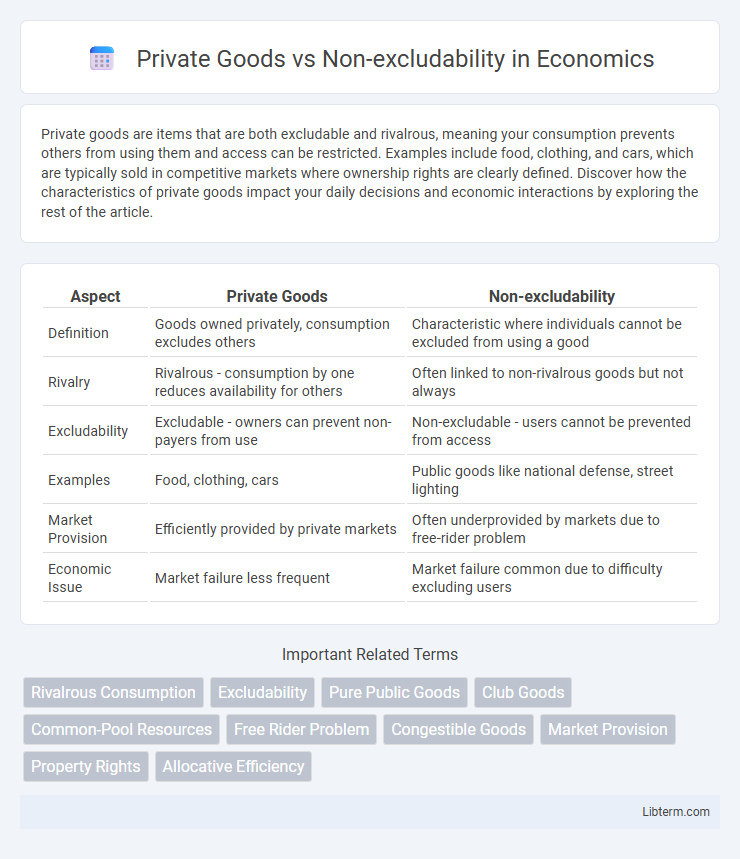Private goods are items that are both excludable and rivalrous, meaning your consumption prevents others from using them and access can be restricted. Examples include food, clothing, and cars, which are typically sold in competitive markets where ownership rights are clearly defined. Discover how the characteristics of private goods impact your daily decisions and economic interactions by exploring the rest of the article.
Table of Comparison
| Aspect | Private Goods | Non-excludability |
|---|---|---|
| Definition | Goods owned privately, consumption excludes others | Characteristic where individuals cannot be excluded from using a good |
| Rivalry | Rivalrous - consumption by one reduces availability for others | Often linked to non-rivalrous goods but not always |
| Excludability | Excludable - owners can prevent non-payers from use | Non-excludable - users cannot be prevented from access |
| Examples | Food, clothing, cars | Public goods like national defense, street lighting |
| Market Provision | Efficiently provided by private markets | Often underprovided by markets due to free-rider problem |
| Economic Issue | Market failure less frequent | Market failure common due to difficulty excluding users |
Understanding Private Goods: Definition and Key Features
Private goods are defined by their excludability and rivalry, meaning consumers can be prevented from using them and one person's consumption reduces availability for others. Key features include exclusivity in access and depletion upon use, which contrasts with non-excludability where goods cannot restrict consumption. Understanding private goods involves recognizing their role in markets where property rights are enforced and consumption is individually controlled.
The Concept of Non-excludability Explained
Non-excludability refers to the characteristic of certain goods where it is impossible or highly costly to prevent individuals who have not paid from accessing or benefiting from the good. Private goods are excludable, meaning owners can restrict access and prevent non-payers from consumption, which contrasts with non-excludable goods such as public parks or street lighting. This concept significantly influences market efficiency and public policy decisions regarding the provision and funding of goods.
Differences Between Private Goods and Non-excludable Goods
Private goods are characterized by both excludability and rivalry, meaning individuals can be prevented from using them and one person's consumption reduces availability for others. Non-excludable goods, in contrast, cannot exclude individuals from consumption, leading to challenges such as free-rider problems, but may or may not be rivalrous. The fundamental difference lies in excludability, with private goods ensuring exclusive access while non-excludable goods allow open access regardless of payment.
Characteristics of Private Goods
Private goods are characterized by excludability and rivalrous consumption, meaning individuals can be prevented from using them, and one person's consumption reduces availability for others. These goods typically include items like food, clothing, and cars, where ownership and usage are exclusive and limited. The market effectively regulates private goods through pricing mechanisms that reflect scarcity and demand.
Examples of Non-excludable Goods
Public parks, street lighting, and national defense exemplify non-excludable goods, as individuals cannot be effectively barred from their use regardless of payment. Unlike private goods, which are both excludable and rivalrous, non-excludable goods allow widespread access, often leading to free-rider problems. These characteristics challenge traditional market mechanisms and necessitate government intervention or collective funding to ensure provision and maintenance.
Consumption and Rivalry in Private Goods
Private goods exhibit both excludability and rivalry in consumption, meaning individuals can be prevented from using them, and one person's consumption reduces availability for others. The rivalry characteristic ensures that when a private good is consumed, it diminishes the quantity or quality accessible to others, creating competitive demand. This exclusivity and rivalry in consumption drive market mechanisms like pricing and property rights to allocate private goods efficiently.
Public Goods vs. Private Goods: A Comparative Analysis
Private goods are characterized by excludability and rivalrous consumption, meaning individuals can be prevented from using them and one person's use reduces availability to others. Public goods exhibit non-excludability and non-rivalry, allowing multiple individuals to benefit simultaneously without excluding others from consumption. This fundamental distinction impacts market efficiency and government intervention strategies in allocating resources effectively.
The Role of Excludability in Market Efficiency
Excludability plays a crucial role in market efficiency by enabling producers to restrict access to private goods, ensuring that only paying consumers can benefit, which incentivizes production and allocation of resources. Non-excludable goods, such as public goods like clean air, lead to market failures because producers cannot effectively charge consumers, resulting in underproduction or free-rider problems. Therefore, excludability directly affects the ability of markets to allocate resources efficiently by influencing consumer incentives and producer revenues.
Challenges Associated with Non-excludable Goods
Non-excludability in goods creates significant challenges, notably the free rider problem, where individuals consume benefits without paying, leading to underfunding and inefficiency. This difficulty in excluding users discourages private companies from investing in such goods, resulting in market failures and the need for government intervention. Public goods like clean air or national defense exemplify this, as their non-excludable nature complicates sustainable provision and resource allocation.
Policy Implications: Managing Private and Non-excludable Goods
Effective policy management distinguishes private goods, characterized by excludability and rivalry, from non-excludable goods that present challenges like free-riding and overconsumption. Policymakers often implement regulations, subsidies, or public provision to address market failures associated with non-excludable goods, such as public safety or clean air, ensuring equitable access and sustainable use. In contrast, private goods rely on market mechanisms and property rights enforcement to maintain efficient allocation and incentivize production.
Private Goods Infographic

 libterm.com
libterm.com